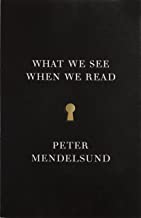What We See When We Read by Peter Mendelsund 2014
This is a fascinating and engrossing book that left me with some new and exciting vantage points on reading. Recommended by a friend and written and illustrated by the associate art director at Knopf and book cover artist, it delves into the actual mechanics of what it means to read the printed word, especially in novels. Drawing heavily on To the Lighthouse, Anna Karenina, and Moby Dick, Mendelsund explores the anatomy, physiology, and neurology that enable the reader to translate marks on a page into a story in the reader’s mind. He digs into the question that Zadie Smith explored in an essay about who is ‘in charge’, the author or the reader contrasting Barthes (it’s the reader) with Nabokov (it’s the writer). The book is filled with the author’s illustrations, not a surprise given his experience in designing book covers. His favorite example of the intersection between seeing and understanding is Lily Briscoe’s painting in To the Lighthouse which he comments upon as follows: “This painting of hers, with its abstractions, is Woolf’s central metaphor for the act of creation in general—a writer or poet or composer’s reconstruction of this slippery world of ours.” It is this translation of the external world into creative language that is then translated by the reader’s brain that accounts for the transition from reality (whatever that is) to the writer to the reader. Perhaps the best summary of this book is offered by the author near the end when he writes:
“Authors are curators of experience. They filter the world’s noise, and out of that noise they make the purest signal they can—out of disorder they create narrative. They administer this narrative in the form of a book, and preside, in some ineffable way, over the reading experience. Yet no matter how pure the data set that authors provide to readers—no matter how diligently prefiltered and tightly reconstructed—readers’ brains will continue in their prescribed assignment: to analyze, screen, and sort. Our brains will treat a book as if it were any other of the world’s many unfiltered, encrypted signals. That is, the author’s book, for readers, reverts to a species of noise. We take in as much of the author’s world as we can, and mix this material with our own in the alembic of our reading minds, combining them to alchemize something unique. I would propose that this is why reading ‘works’: reading mirrors the procedure by which we acquaint ourselves with the world. It is not that our narratives necessarily tell us something true about the world (though they might), but rather that the practice of reading feels like, and is like consciousness itself: imperfect; partial; hazy; co-creative.”
I enjoyed this book so very much and will return to it again. The author’s observations on some of my favorite authors and works were both intellectually and emotionally stimulating and satisfying.



